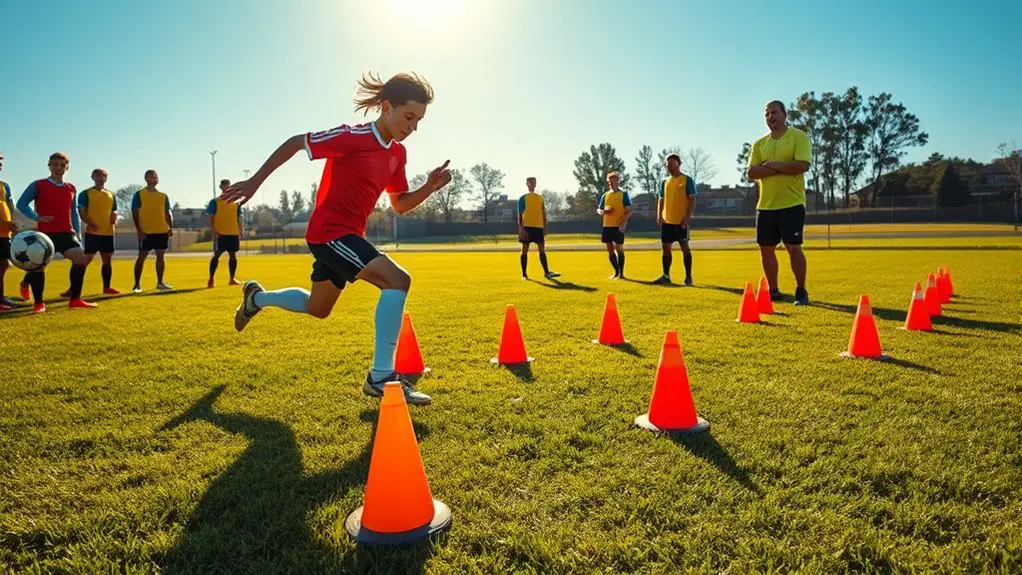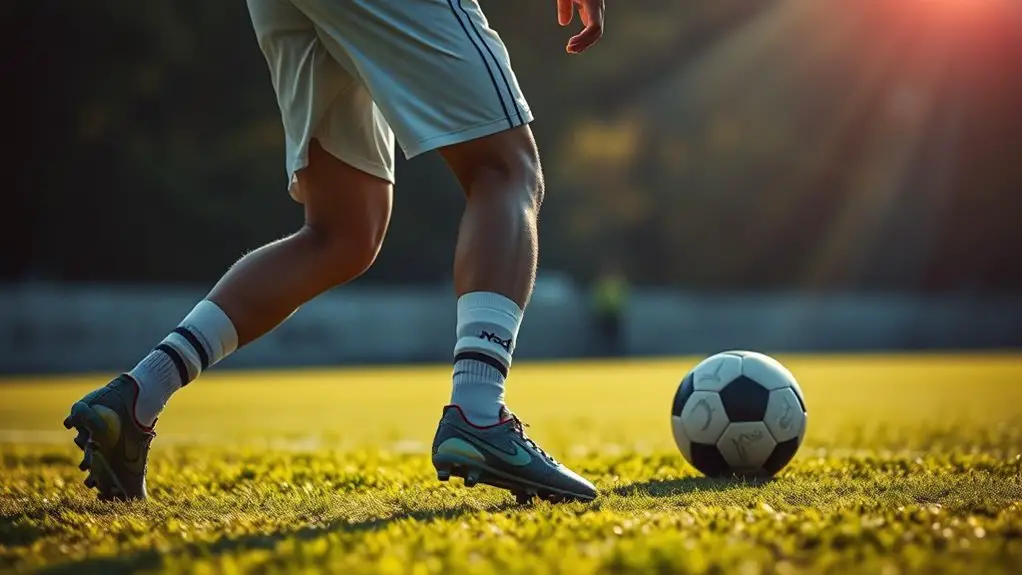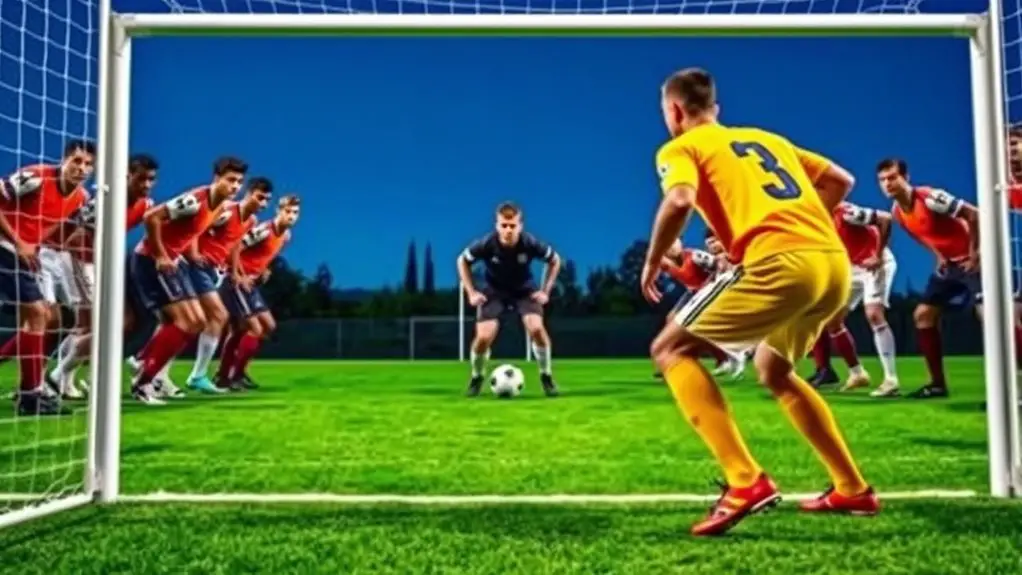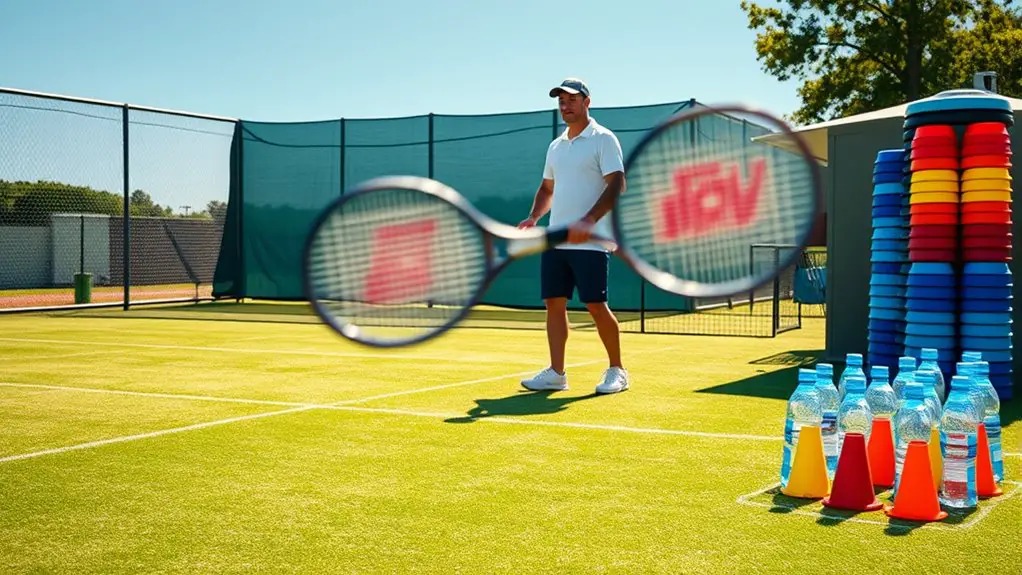Tactical speed training for midfielders sharpens your quick decision-making and responsiveness on the field. You'll work on agility, allowing fast direction changes to outsmart opponents and maintain control under pressure. Incorporating drills like cone and ladder exercises enhances your foot speed and reaction time. Small-sided games help simulate match conditions for faster tactical thinking. Discover how these strategies can elevate your game and lead to improved performance and adaptability during play.
Understanding Tactical Speed in Soccer
Tactical speed in soccer is about more than just raw sprinting; it's the ability to make quick decisions and movements in response to the game's dynamics. As a midfielder, your tactical awareness is essential. You need to read the play, anticipate your teammates' and opponents' actions, and position yourself effectively in the space around you.
It's not just about how fast you can run; it's about knowing when to sprint, when to hold back, and where to be to make an impact. Spatial positioning allows you to exploit gaps in the defense or create passing lanes. The freedom to express yourself on the field comes from mastering this blend of speed and intelligence.
The Importance of Agility for Midfielders
Agility is essential for midfielders, as it allows you to make quick direction changes that can outsmart opponents. With enhanced agility, you'll also boost your defensive capabilities and improve your ball control under pressure. Mastering these skills can greatly elevate your performance on the field. Additionally, incorporating strength training into your regimen will enhance muscle power for directional changes, further improving your agility.
Quick Direction Changes
While many aspects of a midfielder's game are essential, quick direction changes are important for maintaining control and creating opportunities on the field. Mastering these changes can elevate your game, allowing you to navigate tight spaces and outsmart opponents. Here are some key points to focus on:
- Lateral Movement: Develop your side-to-side agility to evade defenders.
- Change Drills: Incorporate specific drills that simulate game scenarios for effective practice.
- Footwork: Improve your foot speed to execute rapid direction shifts effortlessly.
- Balance: Maintain your center of gravity to guarantee stability during quick shifts.
Enhanced Defensive Capabilities
To be an effective midfielder, you need enhanced defensive capabilities that stem from your agility on the field. Your ability to read the game and execute defensive shifts hinges on strong spatial awareness and tactical awareness. Mastering interception techniques and defensive positioning allows you to apply pressure effectively, forcing opponents into mistakes.
| Skill | Description | Importance |
|---|---|---|
| Defensive Positioning | Positioning yourself to block attacks | Prevents goal-scoring chances |
| Interception Techniques | Snatching the ball from opponents | Regains possession quickly |
| Communication Strategies | Coordinating with teammates | Strengthens team defense |
| Recovery Runs | Sprinting back after attacking | Guarantees defensive stability |
Improved Ball Control
Mastering ball control is essential for midfielders, as it directly impacts your ability to maneuver through tight spaces and maintain possession under pressure. To enhance your ball mastery and touch sensitivity, focus on these key aspects:
- Dribbling Drills: Practice various dribbling techniques in confined areas to improve agility and control.
- Close Touch Exercises: Use small, quick touches to familiarize yourself with the ball and enhance feel.
- 1v1 Situations: Engage in one-on-one drills to develop quick decision-making and ball protection skills.
- Passing Precision: Work on short and long-range passing to guarantee you can distribute the ball effectively under pressure.
Embrace these practices, and you'll reveal your potential as a midfielder, guiding the pitch with freedom and confidence.
Key Components of Tactical Speed Training
To enhance your tactical speed, you need to focus on a few key components. Game situation awareness helps you read the play, while quick decision-making skills allow you to act swiftly. Finally, improving your reaction time enhances your ability to respond effectively in critical moments. Regular practice of agility drills can significantly boost your reflexes and overall tactical speed on the field.
Game Situation Awareness
How can a midfielder enhance their game situation awareness? Developing strong game awareness is key to making impactful plays. Here are four essential strategies to improve your situational analysis:
- Observe the Field – Constantly scan your surroundings to understand player positions and potential threats.
- Anticipate Movements – Predict your teammates' and opponents' actions based on their positioning and tendencies.
- Communicate – Use clear, concise language with teammates to share insights and increase collective awareness.
- Reflect Post-Game – Analyze your decisions during the match to identify areas for improvement and reinforce learning.
Quick Decision-Making Skills
Quick decision-making skills are essential for midfielders aiming to elevate their game. You need to develop effective decision-making strategies that allow you to assess situations quickly and choose the best course of action. Engaging in cognitive training can sharpen your mental agility, helping you recognize patterns and anticipate opponents' moves. Practice drills that simulate game scenarios, pushing you to make rapid decisions under pressure. This training not only enhances your tactical awareness but also boosts your confidence on the field. Remember, the ability to think fast can set you apart, giving you the freedom to express your style while making impactful contributions to your team. Embrace these skills, and watch your performance soar!
Reaction Time Enhancement
While developing your tactical speed, enhancing your reaction time is essential for a midfielder. Quick reactions can make the difference between winning and losing possession. Here are some key strategies to improve your reaction time:
- Reaction Drills: Incorporate drills that require immediate movement in response to stimuli. Use cones or partners to simulate game scenarios.
- Cognitive Training: Engage in exercises that challenge your decision-making skills, like interactive games or reaction-based apps.
- Visual Cues: Practice responding to visual indicators, such as colored flags or lights, to sharpen your anticipation.
- Footwork Exercises: Work on agility ladders and quick feet drills to enhance your physical response speed.
Drills to Enhance Reaction Time
Enhancing reaction time is essential for midfielders, as split-second decisions can dictate the flow of the game. To sharpen your instincts, incorporate reaction drills into your training routine. One effective drill is the ball drop exercise, where a partner drops a ball, and you sprint to catch it before it hits the ground. This hones your reflexes and quickens your response.
Additionally, cognitive training can complement your physical drills. Use apps or games designed to improve your decision-making speed under pressure. For instance, screen-based reaction tests can simulate game scenarios that require you to make quick choices, boosting your mental agility. Implementing visualization techniques can further enhance your ability to respond instinctively during crucial moments.
Lastly, practice small-sided games with unpredictable elements. This puts you in situations where you must react swiftly and adapt to changing dynamics. By integrating these drills, you'll enhance your ability to respond effectively when it matters most on the pitch.
Incorporating Change of Direction Exercises
Change of direction exercises are crucial for enhancing your agility and overall performance on the field. By incorporating effective drills, you can improve your ability to react and maneuver quickly during matches. Let's explore the benefits and some key drills that can help you master these crucial skills. Additionally, these drills can significantly boost cardiovascular fitness, which is vital for maintaining endurance throughout the game.
Benefits of Change Direction
When you incorporate change of direction exercises into your training regimen, you release a host of benefits that can elevate your performance on the field. These change benefits not only improve your agility but also enhance your tactical applications in matches. Here are four key advantages:
- Improved Agility: You'll react quicker to opponents and create space when necessary.
- Enhanced Balance: Your stability will allow you to maintain control during high-pressure situations.
- Increased Speed: Sharper turns and faster changes will help you outpace defenders.
- Boosted Confidence: Mastering these skills empowers you to take risks and seize opportunities in matches.
Incorporating these exercises can truly free your playing style and elevate your game to another level.
Effective Drills to Implement
To effectively incorporate change of direction exercises into your training, consider implementing a variety of drills that target agility and speed. Start with cone drills, where you weave in and out, sharpening your tactical awareness. Ladder drills can enhance foot speed and coordination, essential for quick changes in direction. Don't forget situational training; simulate game scenarios where you must react and adapt your movements quickly. Include shuttle runs that force you to pivot and sprint, mimicking real-match conditions. Partner up for 1v1 drills, focusing on your ability to read the opponent's movements and adjust accordingly. These exercises not only build your physical skills but also boost your confidence, giving you the freedom to express your playing style on the pitch.
Speed Endurance and Its Impact on Performance
While speed endurance might not be the first thing that comes to mind for many midfielders, it plays an essential role in overall performance on the field. Achieving a higher speed threshold allows you to maintain your pace over the duration of the match, giving you an edge. Here's how speed endurance can impact your game:
- Sustained Sprinting: You can keep up high-intensity play longer, outpacing opponents.
- Recovery Time: Your ability to recover quickly between sprints means you stay effective throughout the match.
- Tactical Positioning: You can reposition more effectively, staying in the right place at the right time.
- Increased Stamina: Longer endurance training builds your overall stamina, allowing you to perform at your best when it matters. Additionally, building stamina is a necessity for excelling in high-intensity sports.
Utilizing Small-Sided Games for Tactical Speed
Small-sided games offer a dynamic way to enhance your tactical speed, as they create an environment where quick decision-making and rapid movement are essential. By engaging in these games, you can experiment with different small-sided tactics that push you to think and act faster. For example, try altering the number of players or the size of the field to create game variations that challenge your adaptability and spatial awareness.
These setups not only boost your technical skills but also simulate match conditions, making you more comfortable under pressure. As you navigate tight spaces and respond to opponents, you'll sharpen your ability to read the game and make split-second decisions. Embrace the freedom to explore various strategies during these games, and you'll find that your tactical speed will greatly improve, giving you an edge on the field.
Assessing and Tracking Progress in Training
Measuring your progress in tactical speed training is essential for understanding your development as a midfielder. Tracking your improvement keeps you motivated and helps you identify areas for growth. Here are some ways to assess your progress metrics and establish training benchmarks:
Measuring your tactical speed progress is vital for growth and motivation as a midfielder.
- Timed Sprints: Record your sprint times over various distances to gauge speed improvements.
- Dribbling Drills: Monitor your completion times for dribbling exercises to evaluate your agility and ball control.
- Game Performance: Analyze your on-field performance metrics, such as successful passes and tackles, to see how your speed influences your play.
- Video Analysis: Review footage of your training sessions and games to pinpoint tactical decisions and speed-related actions. Additionally, proper footwork enhances your overall performance by improving control and precision on the field.
Nutrition and Recovery for Optimal Performance
To maximize the benefits of your tactical speed training, paying attention to nutrition and recovery is key. You need to fuel your body with the right nutritional strategies to enhance performance and sustain energy levels. Prioritize whole foods rich in carbohydrates, proteins, and healthy fats. Think about meals packed with lean meats, fruits, vegetables, and whole grains to keep you sharp on the field.
Equally important are your recovery techniques. After intense training, allow your body to heal and recharge. This means getting enough sleep, staying hydrated, and considering practices like stretching or foam rolling to ease muscle tension. Incorporating active recovery sessions, such as light jogging or yoga, can also help maintain your flexibility and prevent injuries. When you focus on both nutrition and recovery, you're setting yourself up for peak performance, giving you the freedom to move and play at your best. Additionally, make sure to stay hydrated throughout your training to avoid fatigue and cramps that could hinder your performance.
Case Studies: Successful Midfielders and Their Training Regimens
While many midfielders excel on the pitch, their training regimens often reveal the nuances behind their success. Take a look at some famous midfielders and their distinct training techniques that set them apart:
The success of midfielders often lies in their unique training methods that enhance their on-field performance.
- Kevin De Bruyne: Focuses on agility drills and quick footwork to enhance his playmaking abilities.
- N'Golo Kanté: Incorporates endurance training and interval sprints to maintain his relentless energy throughout the match.
- Luka Modrić: Utilizes ball control exercises combined with tactical simulations to sharpen his decision-making under pressure.
- Bruno Fernandes: Engages in varied passing drills and shooting practice to improve his attacking threat and creativity. Additionally, many midfielders benefit from reaction time drills to enhance their responsiveness during critical moments in games.
Frequently Asked Questions
How Often Should Midfielders Train for Tactical Speed?
You might be wondering how often you should train for tactical speed. Frequency guidelines suggest a balanced approach, aiming for two to three sessions a week. It's important to take into account training intensity, too; mixing high-intensity drills with lower-impact sessions allows your body to recover while still improving. This way, you'll find the freedom to explore your capabilities without risking burnout. Listen to your body, and adjust your training as needed for peak performance.
What Age Is Best to Start Tactical Speed Training?
When you're considering the best age to start tactical speed training, it's crucial to focus on youth development. Generally, kids around 12-14 are ready to embrace this kind of training. At this age, they're more adaptable and can grasp varied training methodologies. Starting early allows them to develop skills while keeping the training enjoyable. It's all about fostering their passion for the game without overwhelming them, giving them the freedom to grow.
Can Tactical Speed Training Prevent Injuries?
You might wonder if tactical speed training can actually help with injury prevention. Well, it can! By improving your tactical agility, you enhance your body's ability to react quickly and efficiently, which reduces the risk of injuries. When you're agile, you're less likely to get caught in awkward positions that lead to strains or sprains. So, embracing this type of training not only boosts your performance but also keeps you free from injury.
What Equipment Is Needed for Speed Training?
Imagine racing through an open field, unencumbered and swift. For speed training, you'll need a few key pieces of equipment. Agility ladders are essential for improving footwork and coordination during speed drills. Cones can help create obstacle courses that challenge your agility. Resistance bands can also add intensity to your workouts. With the right tools, you'll release your potential and feel the thrill of speed like a bird soaring through the sky.
How Do I Motivate Midfielders During Speed Training?
To motivate midfielders during speed training, you can use various motivation techniques. Create a friendly competition, setting benchmarks that they can aim to beat. Celebrate their achievements with training rewards like gear or extra practice time. Encourage individual goals to foster personal freedom in their development. Keep the atmosphere fun and light-hearted; this way, they'll feel more engaged and excited about pushing their limits and improving together.




